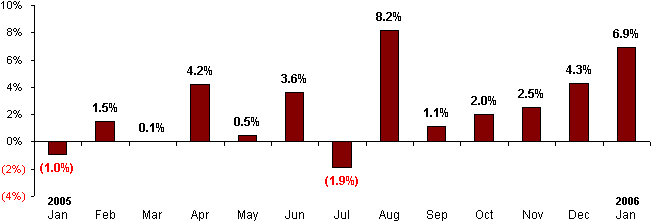IDEX Online Research: U.S. Jewelry Sales Strong in January
March 16, 06
U.S. jewelry sales in January were extremely strong. This continued the trend of total U.S. retail sales, which posted stunning results in January due to abnormally warm weather. In addition, comparisons against January 2005 were easy. The graph below summarizes specialty jewelers’ sales trends for the past 13 months.
| U.S. Specialty Jeweler' Sales Trends 2005-2006 |
Sales volatility this time of year is common. January and February are the slowest months of the year for most retailers. Hence, small changes in sales trends show up as large percentage gains or losses. Further, sales are particularly sensitive to weather during the winter. For example, preliminary U.S. retail sales were weak in February due to particularly blustery winter weather – cold, snowy conditions over much of the country. The Department of Commerce reports top-line sales with a one-month lag, but sub-categories such as jewelry are reported with a two-month lag. Thus, if February jewelry sales follow aggregate U.S. retail demand, we would look for modest Valentine’s sales.
Sales volatility remains in the outlook. Last year, Easter was in late March; this year, it is in mid-April. Thus, the bulk of Easter sales will occur in April. As a result, jewelers should not read too much into shifting sales trend for the next couple of months.
Drivers of sales for the next several months are mixed. As long as the labor market remains healthy – which is boosting wage and salary income – retail sales should show moderate gains. Asset gains continue to boost personal balance sheets for many households, though appreciation of home values have begun to slow. However, continued relatively low interest rates facilitate borrowing against those assets (particularly homes).
The biggest drag on retail sales remains high energy prices. Retail gasoline prices surged this week in the U.S. Consumer debt burdens are near record levels, and will be increasing due to higher interest rates. Higher interest rates will reduce the desirability to borrow, especially given the negative savings rate and the lack of pent-up demand for many goods. Rapidly rising benefit costs, such as health insurance, are a constraint on cash wages. Finally, the return of retail price inflation is making purchasing less attractive to consumers.
We believe the mixed consumer fundamentals will result in healthy, but not stellar, sales growth for the next several months.
